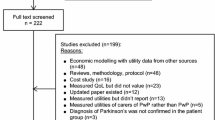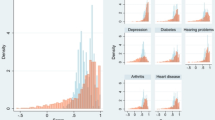Abstract
Purpose
Comparative studies between Euroqol-5D (EQ-5D) and ShortForm 6D (SF-6D) utilities have been performed for a number of diseases, but not yet for orphan diseases. Pompe disease is an orphan disease with a prevalence of <5/10,000, characterized by impaired ambulatory and pulmonary functioning. We compared the psychometric properties of EQ-5D and SF-6D in patients with this disease and assessed their convergent validity, discriminative ability and sensitivity to change.
Methods
EQ-5D utilities and SF-6D utilities were computed using the UK value set. Dimensions and utilities of the two instruments were compared by correlation coefficients and descriptive statistics. We assessed whether EQ-5D and SF-6D were able to discriminate between different levels of severity and examined sensitivity to change for patients with multiple observations.
Results
Correlations between theoretically related dimensions of the EQ-5D and SF-6D were highly significant and were moderate to strong (range rho = 0.409–0.564). Utility values derived from the two instruments were similar (mean EQ-5D = 0.670; mean SF-6D = 0.699) and correlated strongly (rho = 0.591). Discriminative properties were somewhat better for EQ-5D; mean changes and effect sizes were better for SF-6D.
Conclusions
Overall, we conclude that both instruments appear to be equally appropriate with respect to assessing utilities in Pompe disease, but neither of them performed excellently. The descriptive system of the SF-6D describes health states for Pompe disease more accurately. EQ-5D showed better discriminative properties. The SF-6D performed better with respect to sensitivity to change.


Similar content being viewed by others
References
European Commission. (2000). Regulation (EC) no 141/2000 of the European parliament and of the council of 16 December 1999 on orphan medicinal products. Official Journal of the European Communities, L18/1.
Haffner, M. E. (2006). Adopting orphan drugs—two dozen years of treating rare diseases. New England Journal of Medicine, 354, 445–447.
Schey, C., Milanova, T., & Hutchings, A. (2011). Estimating the budget impact of orphan medicines in Europe: 2010–2020. Orphanet Journal of Rare Diseases, 6, 62.
Drummond, M. F., Wilson, D. A., Kanavos, P., Ubel, P., & Rovira, J. (2007). Assessing the economic challenges posed by orphan drugs. International Journal of Technology Assessment in Health Care, 23, 36–42.
van der Ploeg, A. T., & Reuser, A. J. J. (2008). Pompe’s disease. The Lancet, 372, 1342–1353.
Ausems, M. G. E. M., Verbiest, J., Hermans, M. M. P., Kroos, M. A., Beemer, F. A., Wokke, J. H. J., et al. (1999). Frequency of glycogen storage disease type II in the Netherlands: Implications for diagnosis and genetic counselling. European Journal of Human Genetics, 7, 713–716.
Van der Beek, N. A. M. E., Van Capelle, C. I., Van der Velden-Van Etten, K. I., Hop, W. C. J., Van den Berg, B., Reuser, A. J. J., et al. (2011). Rate of progression and predictive factors for pulmonary outcome in children and adults with Pompe disease. Molecular Genetics and Metabolism, 104, 129–136.
Müller-Felber, W., Horvath, R., Gempel, K., Podskarbi, T., Shin, Y., Pongratz, D., et al. (2007). Late onset Pompe disease: Clinical and neurophysiological spectrum of 38 patients including long-term follow-up in 18 patients. Neuromuscular Disorders, 17, 698–706.
Van der Beek, N. A. M. E., De Vries, J. M., Hagemans, M. L., Hop, W. C., Kroos, M. A., Wokke, J. H., et al. (2012). Clinical features and predictors for disease natural progression in adults with Pompe disease: A nationwide prospective observational study. Orphanet Journal of Rare Diseases, 7, 88.
Van der Beek, N. A. M. E., Hagemans, M. L. C., Reuser, A. J. J., Hop, W. C. J., van der Ploeg, A. T., Van Doorn, P. A., et al. (2009). Rate of disease progression during long-term follow-up of patients with late-onset Pompe disease. Neuromuscular Disorders, 19, 113–117.
Hagemans, M. L. C., Janssens, A., Winkel, L. P. F., Sieradzan, K. A., Reuser, A. J. J., Van Doorn, P. A., et al. (2004). Late-onset Pompe disease primarily affects quality of life in physical health domains. Neurology, 63, 1688–1692.
Kanters, T. A., Hagemans, M. L. C., Van der Beek, N. A. M. E., Rutten, F. F. H., van der Ploeg, A. T., & Hakkaart, L. (2011). Burden of illness of Pompe disease in patients only receiving supportive care. Journal of Inherited Metabolic Disease, 34, 1045–1052.
Güngör, D., De Vries, J. M., Hop, W. C. J., Reuser, A. J. J., Van Doorn, P. A., van der Ploeg, A. T., et al. (2011). Survival and associated factors in 268 adults with Pompe disease prior to treatment with enzyme replacement therapy. Orphanet Journal of Rare Diseases, 6, 34.
Lamers, L. M., Bouwmans, C. A. M., Van Straten, A., Donker, M. C. H., & Hakkaart, L. (2006). Comparison of EQ-5D and SF-6D utilities in mental health patients. Health Economics, 15, 1229–1236.
Joore, M., Brunenberg, D., Nelemans, P., Wouters, E., Kuijpers, P., Honig, A., et al. (2010). The impact of differences in EQ-5D and SF-6D utility scores on the acceptability of cost-utility ratios: Results across five trial-based cost-utility studies. Value in Health, 13, 222–229.
Sach, T. H., Barton, G. R., Jenkinson, C., Doherty, M., Avery, A. J., & Muir, K. R. (2009). Comparing cost-utility estimates: Does the choice of EQ-5D or SF-6D matter? Medical Care, 47, 889–894.
Brooks, R. (1996). EuroQol: The current state of play. Health Policy, 37, 53–72.
Brazier, J., Roberts, J., & Deverill, M. (2002). The estimation of a preference-based measure of health from the SF-36. Journal of Health Economics, 21, 271–292.
Dolan, P. (1997). Modeling valuations for EuroQol health states. Medical Care, 35, 1095–1108.
Brazier, J., Tsuchiya, A., Roberts, J., & Busschbach, J. (2004). A comparison of the EQ-5D and the SF-6D across seven patient groups. Health Economics, 13, 873–884.
Stavem, K., Frøland, S. S., & Hellum, K. B. (2005). Comparison of preference-based utilities of the 15D, EQ-5D and SF-6D in patients with HIV/AIDS. Quality of Life Research, 14, 971–980.
Szende, A., Leidy, N. K., Ståhl, E., & Svensson, K. (2009). Estimating health utilities in patients with asthma and COPD: Evidence on the performance of EQ-5D and SF-6D. Quality of Life Research, 18, 267–272.
Marra, C. A., Woolcott, J. C., Kopec, J. A., Shojania, K., Offer, R., Brazier, J. E., et al. (2005). A comparison of generic, indirect utility measures (the HUI2, HUI3, SF-6D, and the EQ-5D) and disease-specific instruments (the RAQoL and the HAQ) in rheumatoid arthritis. Social Science and Medicine, 60, 1571–1582.
Fisk, J. D., Brown, M. G., Sketris, I. S., Metz, L. M., Murray, T. J., & Stadnyk, K. J. (2005). A comparison of health utility measures for the evaluation of multiple sclerosis treatments. Journal of Neurology, Neurosurgery and Psychiatry, 76, 58–63.
Quanjer, P. H., Tammeling, G. J., Cotes, J. E., Pedersen, O. F., Peslin, R., & Yernault, J. C. (1993). Lung volumes and forced ventilatory flows. Report working party standardization of lung function tests, European community for steel and coal. official statement of the European respiratory society. European Respiratory Journal. Supplement, 16, 5–40.
Medical Research Council. (1986). Aids to the examination of the peripheral nervous system. London: Tindall.
De Vries, J. M., Van der Beek, N. A. M. E., Hop, W. C. J., Karstens, F. P. J., Wokke, J. H., De Visser, M., et al. (2012). Effect of enzyme therapy and prognostic factors in 69 adults with Pompe disease: An open-label single-center study. Orphanet Journal of Rare Diseases, 7, 73.
Field, A. P. (2009). Discovering statistics using SPSS. London: SAGE publications Ltd.
Streiner, D. L., & Norman, G. R. (2008). Health measurement scales. Oxford: Oxford University Press.
Ghislandi, S., Apolone, G., Garattini, L., & Ghislandi, I. (2002). Is EQ-5D a valid measure of HRQoL in patients with movement disorders? The European Journal of Health Economics, 3, 125–130.
Janssen, M. F., Birnie, E., Haagsma, J. A., & Bonsel, G. J. (2008). Comparing the standard EQ-5D three-level system with a five-level version. Value in Health, 11, 275–284.
McTaggart-Cowan, H. M., Marra, C. A., Yang, Y., Brazier, J. E., Kopec, J. A., FitzGerald, J. M., et al. (2008). The validity of generic and condition-specific preference-based instruments: The ability to discriminate asthma control status. Quality of Life Research, 17, 453–462.
Khanna, D., Furst, D. E., Wong, W. K., Tsevat, J., Clements, P. J., Park, G. S., et al. (2007). Reliability, validity, and minimally important differences of the SF-6D in systemic sclerosis. Quality of Life Research, 16, 1083–1092.
Lamers, L. M., McDonnell, J., Stalmeier, P. F. M., Krabbe, P. F. M., & Busschbach, J. J. V. (2006). The Dutch tariff: Results and arguments for an effective design for national EQ-5D valuation studies. Health Economics, 15, 1121–1132.
Acknowledgments
This study was financially supported by the Netherlands Organization for Health Research and Development (ZonMw; grant no. 152001005). The authors would like to thank M.L.C. Hagemans for comments on earlier versions of the manuscript.
Author information
Authors and Affiliations
Corresponding author
Rights and permissions
About this article
Cite this article
Kanters, T.A., Redekop, W.K., Kruijshaar, M.E. et al. Comparison of EQ-5D and SF-6D utilities in Pompe disease. Qual Life Res 24, 837–844 (2015). https://doi.org/10.1007/s11136-014-0833-2
Accepted:
Published:
Issue Date:
DOI: https://doi.org/10.1007/s11136-014-0833-2




